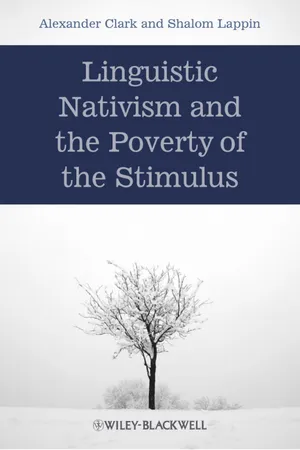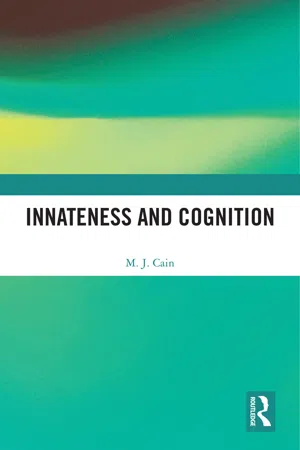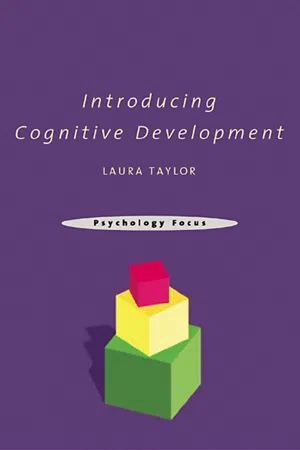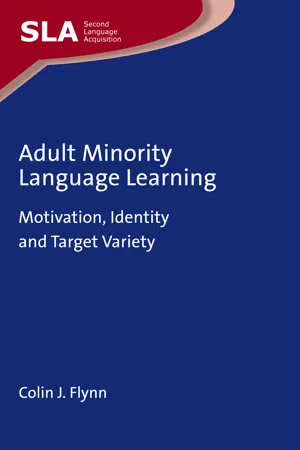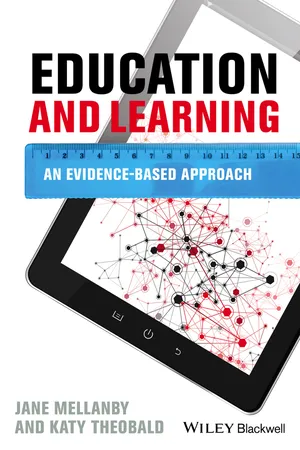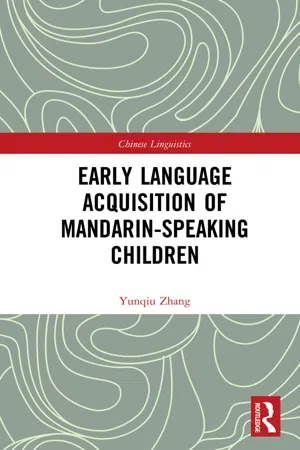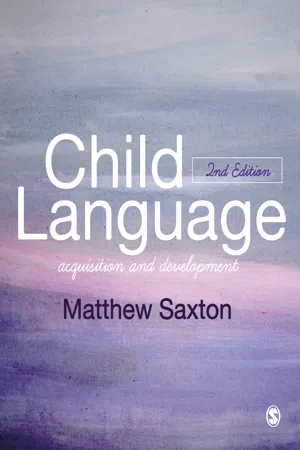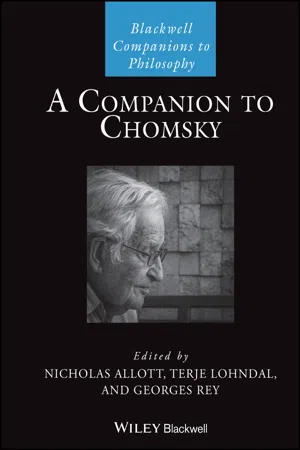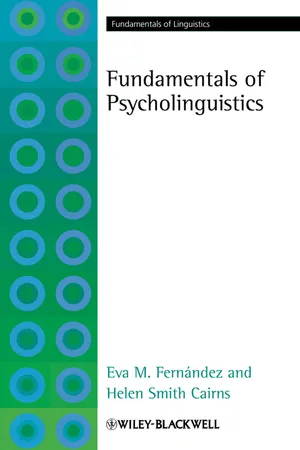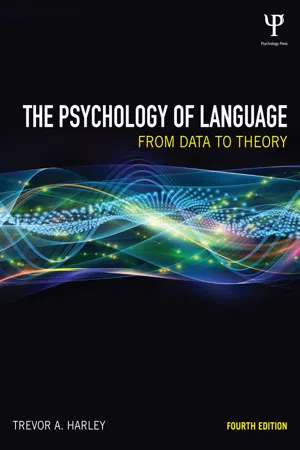Languages & Linguistics
Nativist
"Nativist" refers to the belief that humans are born with an innate capacity for language acquisition. In the field of linguistics, nativists argue that the ability to learn language is a natural, inherent trait rather than a learned behavior. This perspective is often associated with Noam Chomsky's theory of Universal Grammar, which posits that all languages share a common underlying structure.
Written by Perlego with AI-assistance
Related key terms
12 Key excerpts on "Nativist"
- Alexander Clark, Shalom Lappin(Authors)
- 2010(Publication Date)
- Wiley-Blackwell(Publisher)
1 Introduction: Nativism in Linguistic TheoryClearly human beings have an innate, genetically specified cognitive endowment that allows them to acquire natural language. The precise nature of this endowment is, however, a matter of scientific controversy. A variety of views on this issue have been proposed. We take two positions as representative of the spectrum. The first takes language acquisition and use as mediated primarily by genetically determined language-specific representations and mechanisms. The second regards these processes as largely or entirely the result of domain-general learning procedures.The debate between these opposing perspectives does not concern the existence of innately specified cognitive capacities. While humans learn languages with a combinatorial syntax, productive morphology, and (in all cases but sign language) phonology, other species do not. Hence, people have a unique, species-specific ability to learn language and process it. What remains in dispute is the nature of this innate ability, and, above all, the extent to which it is a domain-specific linguistic device. This is an empirical question, but there is a dearth of direct evidence about the actual brain and neural processes that support language acquisition. Moreover, invasive experimental work is often impossible for ethical or practical reasons. The problem has frequently been addressed abstractly, through the study of the mathematical and computational processes required to produce the outcome of learning from the data available to the learner. As a result, choosing among competing hypotheses on the basis of tangible experimental or observational evidence is generally not an option.The concept of innateness is, itself, acutely problematic. It lacks an agreed biological or psychological characterization, and we will avoid it wherever possible. It is instructive to distinguish between innateness as a biological concept from the idea of innateness that has figured in the history of philosophy, and we will address this difference in section 1.2. More generally, innateness as a genetic property is notoriously difficult to define, and its use is generally discouraged by biologists. Mameli and Bateson (2006) point out that it conflates a variety of different, often not fully compatible, ideas. These include canalization, genetic determinism, presence from birth, and others.- eBook - ePub
- M. J. Cain(Author)
- 2021(Publication Date)
- Routledge(Publisher)
7 Language acquisition and linguistic nativism Introduction Language is a fundamental aspect of human life. It is the primary means by which we communicate complex information, it supports much of our thinking, and it plays a central role in facilitating culture and transmitting cultural practices from one generation to the next. The widespread view amongst theorists who study language is that language is unique to humans; many non-human animals have communication systems but they generally fall short of constituting genuine languages (Fitch, 2010; Hurford, 2014). A natural view is that our linguistic capacities – in particular, our ability to produce sentences to express specific meanings and our ability to understand the sentences produced by our fellows – is based upon a rich body of knowledge of the relevant language. This raises the question as to how we acquire such linguistic knowledge: is any of it innate or is it all learned and are the mechanisms involved in language acquisition domain general or, if not, specific to language? The purpose of this chapter and the next is to examine these questions about language acquisition, questions that have been debated ferociously over the past five decades. Since the late 1950s much of the debate surrounding language acquisition has focussed on the work of Noam Chomsky who, more than anyone, is associated with a Nativist perspective. Chomsky revolutionised linguistics and was central to the cognitive revolution that overthrew behaviourism and gave rise to cognitive science. 1 However, in recent years his work has been subject to much criticism and though still prominent it no longer counts as orthodoxy in linguistics or cognitive science in general. Nevertheless, no serious discussion of language acquisition can ignore Chomsky’s work - eBook - ePub
- Laura Taylor(Author)
- 2004(Publication Date)
- Psychology Press(Publisher)
So far, we have seen that the pattern of language development is remarkably consistent, both within and between cultures, despite the fact that children often have very different experiences. It could be argued that such findings are an artefact of the type of investigations that psychologists conduct. Often, studies take extensive samples of children and then calculate mean ages for specific development, such as the age at which the first word is produced. This could give a misleading impression of development and cloud individual differences and, in turn, environmental contributions to language development. However, the fact that there seems to be a sensitive period for language development, and that this appears to be constrained at a biological level, suggests that a domain-specific bias to learn language exists. Theories of language acquisition differ in terms of the importance they attach to innate predispositions to learn language and the extent to which our environmental experiences assist our language development.Nativist theories
Nativist theories propose that the human capacity for language is innate. Proponents of this approach argue that language skills are incredibly complex and therefore could not be learned purely through observation and imitation, at least not as quickly as they are. They also point to the consistency with which language is acquired across cultures and populations. Given that the amount of and type of exposure to language differs from child to child, they claim that some domain-specific predispositions to language must be present. Nativist theorists also draw on evolutionary theory and argue that the social nature of our society has resulted from and given rise to advances in language skills. Given that language is so vital in today’s society, they suggest that evolution is likely to have equipped neonates with the basic skills and abilities necessary for language to be acquired quickly.Chomsky’s theory
Chomsky (1965) was the first to suggest that humans (and only humans) are born equipped with an innate brain structure, the language acquisition device (LAD) that predetermines the development of language. The LAD consists of some innate knowledge about the structure of language, as well as a set of cognitive and perceptual abilities specialised for language learning. According to Nativist theories such as this, these enable the child to instinctively - eBook - ePub
Adult Minority Language Learning
Motivation, Identity and Target Variety
- Colin J. Flynn(Author)
- 2020(Publication Date)
- Multilingual Matters(Publisher)
positive evidence , i.e. utterances that actually occur in the language, from their environment and from this they work out the rules underlying grammatical structures of the language (Chomsky, 1981). On this view, the only plausible solution to the ‘logical problem of language acquisition’, i.e. the way we come to know language, is to postulate innate mental properties which are designed to process available input and allow the child to build an adult grammar (i.e. mature linguistic competence). This position is often referred to as the Innateness Hypothesis, and its supporters, Nativists.Linked to the Innateness Hypothesis is Chomsky’s notion of linguistic universals. This postulation rests on the observation that the seemingly great variation among human languages is actually very superficial. That is, when one looks at the structure of any and all languages, it becomes clear that they only vary in a small number of ways (Chomsky, 2000: 13). Human language, therefore, demonstrates a number of universal properties along which individual languages (i.e. Spanish, German, Japanese, etc.) can vary only in limited ways. These properties are known as ‘principles’ in Chomskyan terms and they account for the rules of language structure which determine grammaticality. The acquisition of language, then, is explained by the idea that the child inherits knowledge of these language principles via the genetic code. This pre-existing knowledge of the basic principles of language, termed Universal Grammar (UG), drives the acquisitional process and helps to explain how rapidly children master language despite the seemingly varied nature of input from the environment (Chomsky, 2000: 15). In sum, Nativists view the role of the environment as simply to provide linguistic data for the child to internalize. The acquisition process is then guided by UG, the child’s biologically endowed blueprint for language.This account of language has been most clearly developed in Chomsky’s Principles and Parameters Theory (e.g. Chomsky, 1988), which postulates, alongside the inborn knowledge of language principles, the knowledge of parameters, which constitute the ways in which languages can vary. Together these form the language faculty: - eBook - ePub
Education and Learning
An Evidence-based Approach
- Jane Mellanby, Katy Theobald(Authors)
- 2014(Publication Date)
- Wiley-Blackwell(Publisher)
The Nativist approach to first-language acquisition proposes that the motivation and facility to construct language is innate. Noam Chomsky 2 proposed his theory of universal grammar in 1965 – to a largely baffled audience, since the complexity of his oral and written delivery made the content indigestible. However, his theory has been made clearer and has been to some extent modified by Stephen Pinker in his book The Language Instinct. 3 According to Chomsky, the functionality of the human brain naturally includes a universal language acquisition device, or grammar module, which permits the implicit acquisition of the grammar of whatever language it is in which a child is immersed. This Nativist theory proposes that the grammar module contains unlimited possible grammar rules and that exposure to specific language(s) leads to the suppression of those not encountered and the strengthening of those that form part of the language being acquired. There is evidence for a critical or sensitive period for first-language acquisition from a variety of situations. For example, if congenitally deaf children who are born to hearing parents are not exposed to sign language, they will invent a kind of language, ‘home sign’. This does not have the complexity of a mature language but does quite well for communication and does contain its own consistent grammatical rules such as word order. We know from the study of well-documented and widely used sign languages (such as ASL, American Sign Language) that despite using a spatial rather than an auditory medium for communication, sign languages share all the general grammatical properties of spoken languages - eBook - ePub
- Delyth Morris(Author)
- 2010(Publication Date)
- University of Wales Press(Publisher)
homo sapiens, a ‘language instinct’ (Pinker, 1984) that manifests itself in a domain-specific module in the mind which is independent of general cognition (Fodor, 1983). Innate linguistic knowledge facilitates the language-acquisition process, which, apart from lexical learning, is said to involve no more than a process of setting the linguistic ‘parameters’ relevant to the input language received.Those favouring a cognitive approach to language-acquisition theory, as represented in usage-based accounts (e.g., Tomasello, 2000a,b;2003),Constructivism(e.g., Gathercole, 2007),Connectionism (e.g., Elman et al., 1996), and the Competition Model (Bates and MacWhinney, 1989), among others, support the notion that children approach the language-learning process devoid of language, equipped instead with an innate set of general cognitive processes that aid their interpretation, processing, and storage of linguistic input. Language is therefore constructed from the input, is learned within the context of wider cognition, and takes place within the context of socio-cognitive relations with others (Tomasello, 2003). What the Nativist and cognitive approaches have in common, then, is that they both assume some role for certain innate mechanisms, although they differ in terms of what these mechanisms may be.These two conflicting positions allow for the formulation of different predictions about various aspects of the process of language acquisition. Three aspects of that process are explored in this chapter, with particular reference to Welsh. The first of these relates to the nature of the child’s knowledge of language, the second to their rate of learning, and the third to the role of input.Regarding the nature of the child’s knowledge of language, Nativists would argue that abstract linguistic structures are already present at birth in the form of Universal Grammar, as we have seen. Together with innate UG principles, minimal exposure to the language of the environment serves to trigger the setting of language-specific parameters. Children’s knowledge of language is thus innately systematic, and very much rule-based (see e.g., Pinker, 1999). Under the cognitive approach, in contrast, abstract linguistic categories or structures are not simply ‘present’ at birth. Rather, children’s grammars are assembled around individual items and combinations of these. For example, Tomasello (1992) has shown in his Verb Island Hypothesis - Yunqiu Zhang(Author)
- 2019(Publication Date)
- Routledge(Publisher)
Can we combine the two criteria for learning? This is likely to be futile. Different criteria are derived from different theories and their foci on distinctive issues (Nativist theory focuses on the hereditary nature of Universal Grammar, and constructivist theory focuses on the construction process of children’s language). Therefore, without discussing the theories, it is difficult to reconcile the acquisition criteria. Yet the limited nature of human wisdom determines that we cannot have perfect theories, nor can we have flawless research methods. What we can do is to make up for the shortcomings of theories and research methods to the best of our ability.1.1.2 What is innate?
Whether genetic factors play a decisive role in children’s language acquisition is one of the essential differences between the two major views regarding language acquisition. Some scholars in the nativism camp proposed a dual mechanism theory based on the influence of the linguistic environment on language acquisition: Universal Grammar is obtained by children through inheritance, while the lexicon and their pragmatic markings are stored through memory (Pinker, 1999); some scholars put forth the maturation theory based on the fact that children’s grammar is different from adult grammar (Wexler, 1999). But in general, they all acknowledge that children are born with Universal Grammar, and under this premise, they mend the nativism view based on the challenges it faces.The obvious fact is that apart from humans, primates, including chimpanzees and bonobos, cannot learn to speak like children no matter how much input they receive. However, if children do not have a proper language environment after birth (i.e., input), it is equally impossible for them to speak. The cases of John Ssebunya and Genie are good examples that prove this point. As such, neither the innate genetic factors nor the empirical influence of language environment on language acquisition can be denied – they both are indispensable in language acquisition, and it is difficult for them to negate each other. The debate between the rationalist paradigm and the empirical paradigm of the study of language acquisition has been going on for a long time with the two views in diametric opposition. This way of thinking contrasts the innate influence with the environmental influence, even though the two are neither antagonistic nor parallel to each other. Therefore, this kind of argument may not be persuasive or lead to conclusions.- eBook - ePub
Child Language
Acquisition and Development
- Matthew Saxton(Author)
- 2017(Publication Date)
- SAGE Publications Ltd(Publisher)
Non-Nativists, on the other hand, consider grammar to be simply one of many mental achievements acquired by general-purpose cognitive learning mechanisms. We will examine the non-Nativist approach to grammar in the next chapter. In the meantime, we can note that Chomsky promulgates a somewhat startling belief: some of our knowledge of grammar is innate. And lest we think that Chomsky is out on a limb here, swaying in the breeze all by himself, rest assured that he is not alone: The interesting claim that nativism makes is that there are innate ideas, not simply that there are innate learning mechanisms. (Valian, 2014: 90) Discussion point 8.1: Nature–nurture beyond language The nature–nurture question extends far beyond the confines of child language. Think, for example, of the controversy that rages over race and IQ. Herrnstein & Murray (1994), in particular, are famous (infamous, even) for suggesting that African Americans not only do less well on IQ tests than white Americans, but that genetic factors play a significant role in explaining the observed differences (see Mackintosh, 1998, for a survey of this issue that is both balanced and thorough). List different domains of human behaviour - eBook - ePub
- Nicholas Allott, Terje Lohndal, Georges Rey, Nicholas Allott, Terje Lohndal, Georges Rey(Authors)
- 2021(Publication Date)
- Wiley-Blackwell(Publisher)
Part VI Cognitive Science and Philosophy of MindPassage contains an image
28 Nativism
GEORGES REY University of Maryland, College Park, Maryland28.1 Introduction
A central claim of Chomsky's theory of grammar is that the underlying principles of grammar are innate: aside from learning the pronunciation of basic lexical items and possibly setting parameters along which specific grammars can vary, children are essentially born with a computational system, an I‐language, that is governed by principles of Universal Grammar (UG).1 It's a specific computational system somehow realized in the brain that seems (as a whole) peculiar to language and permits children quickly and effortlessly to acquire a linguistic competence very like that of speakers in their community.Chomsky (1965, 1966, 1968/2006) early on associated this hypothesis with views of the traditional “Rationalists,” such as Plato, Descartes, and Leibniz, who argued that many of our ideas especially about logic, geometry, and mathematics, were innate. These views were resisted by the English empiricists such as Locke, Berkeley, and Hume, according to whom all our ideas were “derived from experience”: sensory impressions of experience provided a basis for ideas that were formed either as faint copies of them, or by a process of association, whereby “complex” ideas could be formed that could apply beyond experience. With the development of formal logic in the twentieth century, “logical empiricists/Positivists” allowed logical complexes of experience that were verified or falsified by it. It was widely assumed that people's understanding of language could be understood along these lines. - eBook - ePub
Introducing Second Language Acquisition
Perspectives and Practices
- Kirsten M. Hummel(Author)
- 2013(Publication Date)
- Wiley-Blackwell(Publisher)
guage as unique and different from other cognitive systems. It suggests that humans possess what can be considered as a “language faculty,” i.e., a universal set of underlying principles, called UG, which lends its name to this theoretical approach. The existence of UG allows children to form hypotheses about language when they are exposed to a finite set of examples from their environment. In this regard, UG linguists refer to what has been called the “logical problem of language acquisition,” i.e., that without UG, language learning would be impossible because the input data are insufficiently rich to allow acquisition to occur. The inadequacy of the input is also referred to as the “poverty of the stimulus.” In other words, the language that children are exposed to is characterized by abbreviated utterances, interruptions, ungrammatical sequences, etc., such that they could not possibly receive enough information about all the grammatical, possible sentences of the language by exposure alone; something else must be helping children induce the rules of the language, and that something is the proposed “Universal Grammar” they are born with as part of their genetic endowment. This approach is therefore Nativist, in emphasizing the biologically inherited aspect of UG.The species-specific nature of language is also emphasized in this approach: language is unique to humans; other species' communication systems are fundamentally different from human language.universal grammar (UG) The innate principles and properties that characterize the grammars of all human languages; also used to describe the theoretical view associated with this concept.Language learning in practice: Human language vs animal communicationThere is a long history of interest in examining animal communication systems to see whether they resemble human language and whether certain animal species (such as chimpanzees) can be taught language. Hockett (1960) assembled a list of design features that he considered necessary for a system to be considered a true “language.” In general, animal communication systems lack important features included in that list such as: - eBook - ePub
- Eva M. Fernández, Helen Smith Cairns(Authors)
- 2010(Publication Date)
- Wiley-Blackwell(Publisher)
3 The Biological Basis of LanguageLanguage Is Species Specific Language Is Universal in Humans Language Need Not Be Taught, Nor Can It Be Suppressed Children Everywhere Acquire Language on a Similar Developmental Schedule Language Development Is Triggered by the Environment Anatomical and Physiological Correlates for LanguageLanguage lateralizationNeuroanatomical correlates of language processingThe search for a genetic basis for languageReading and Writing as Cultural Artifacts Summing Up New ConceptsStudy QuestionsPsycholinguistics is a field primarily concerned with how language is represented and processed in the brain. The focus of this book is, therefore, on language as a system controlled by the brain that is different from but closely linked to general cognition. As such, language is an aspect of human biology. We will explore some of the evidence that psycholinguists – and scholars in related fields – have uncovered linking language to human biology. This chapter will also help you distinguish between language as a biological system and language as a sociocultural artifact.The organization of this chapter is based on an important historical precedent. Over 40 years ago a neurologist named Eric Lenneberg adduced five general criteria that help determine whether a system is based in the biology of a species (Lenneberg 1964, 1967). These criteria, each described in the sections that follow, are as valid today as they were then, and we will use them to frame the arguments for the biological basis of language. According to Lenneberg (1967: 371–4), a system is biological if: - eBook - ePub
The Psychology of Language
From Data to Theory
- Trevor A. Harley(Author)
- 2013(Publication Date)
- Psychology Press(Publisher)
Chapter 2 ), and sometimes his political ideas as well. See Cogswell and Gordon (1996), Lyons (1991), and Maher and Groves (1999). A convincing defense of the position that language has an important innate component is presented in a very approachable way by Pinker (1994); see Pinker (1989) for more on formal approaches to language development. See Leonard (2000) for a review of SLI. For more on language development as parameter setting, see Stevenson (1988). Cook and Newson (2007) provide a great deal of material on Chomsky’s work, with particular evidence on language development. In particular, they provide a very clear account of the poverty of the stimulus argument. See McClelland and Seidenberg (2000) and Seidenberg and Elman (1999) for critiques of nativism. For more on early phonological and segmentation skills, see Saffran, Werker, and Werner (2006). See Vihman (1996) for more on phonological development.MacWhinney (1999) is an edited collection with an emphasis on how language is an emergent property. Elman et al. (1996) discuss how connectionism has changed our view of what it means for something to be innate. Their emphasis is on how behavior arises from the interactions between nature and nurture. Plunkett and Elman (1997) provide practical examples of connectionist modeling relevant to this in a simulation environment called tlearn. See Deacon (1997) for a review of the biological basis of language, how it might have evolved, how humans differ from animals, and how language might constrain language learning.Broeder and Murre (2000) present a collection of articles that emphasizes computational modeling of language development. For a review of work on past-tense formation, see Clahsen (1999). Altmann (1997) has a good section on the phonological skills of infants.Passage contains an image
Chapter 5Bilingualism and Second Language AcquisitionIntroductionOddly enough for someone who has written several books on language, languages were my worst subject at school. My worst exam performance by far was in French, where I could literally hardly understand a word. I of course blame the teaching.
Index pages curate the most relevant extracts from our library of academic textbooks. They’ve been created using an in-house natural language model (NLM), each adding context and meaning to key research topics.
